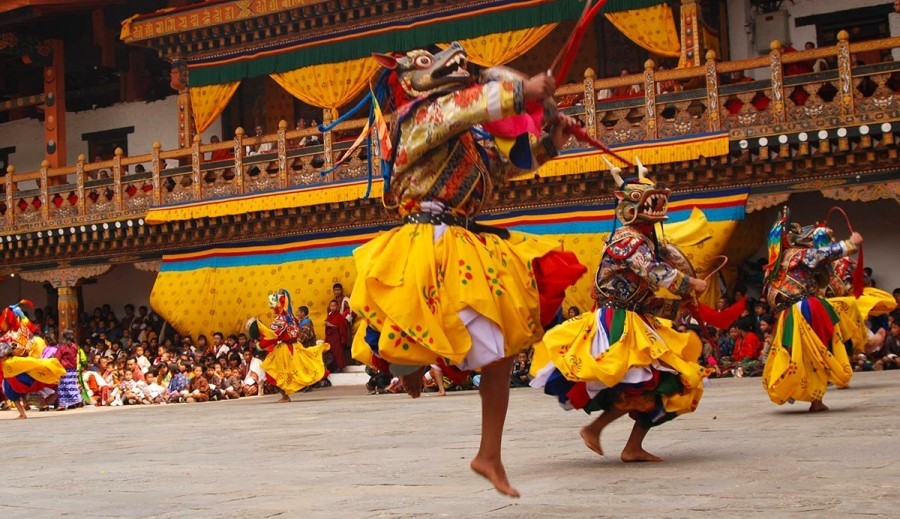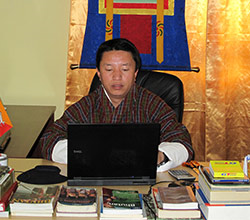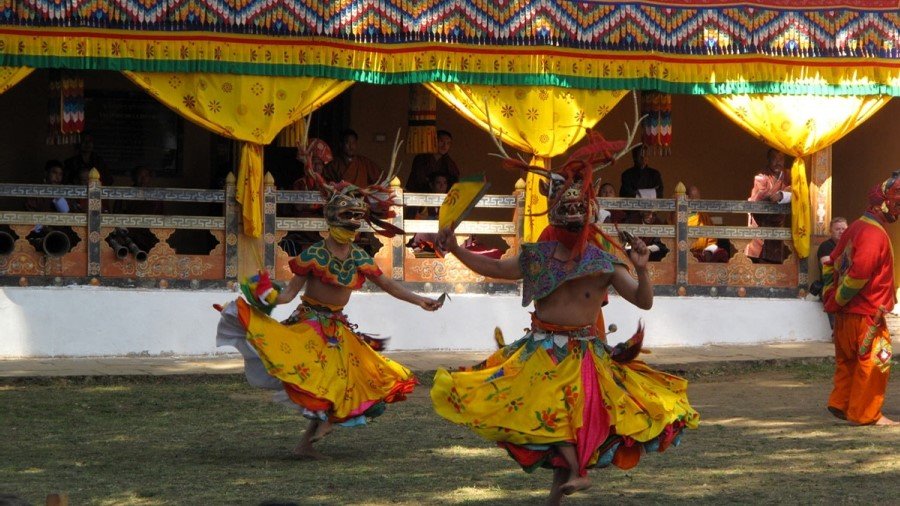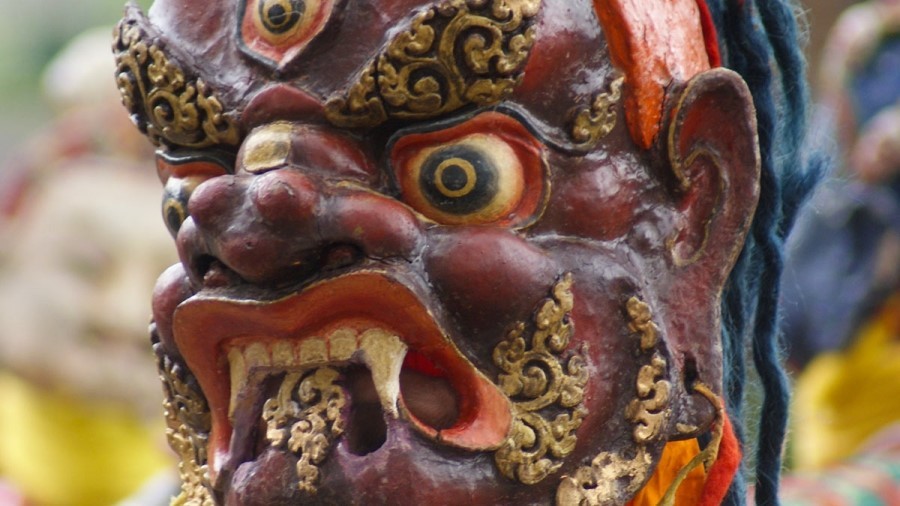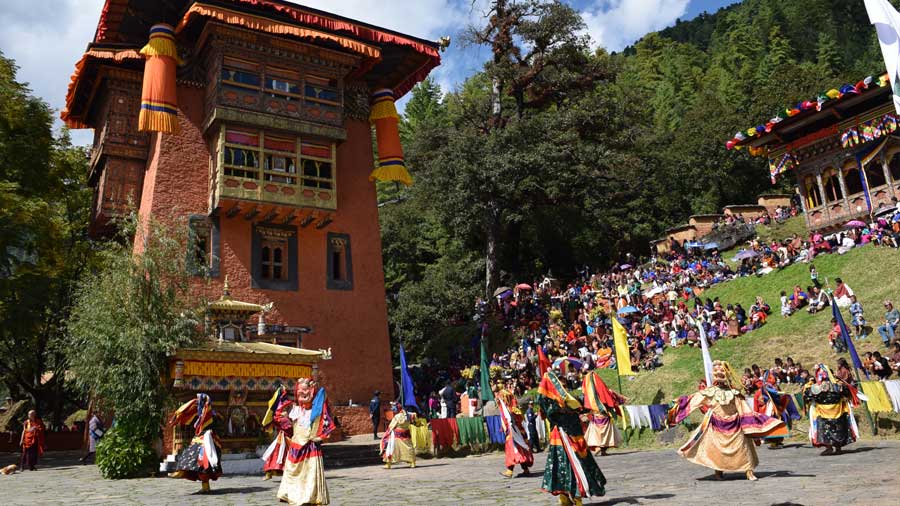‘’In the serene valley of Punakha, the Punakha Tshechu not only preserves our heritage but also brings our community together in joy and reverence.”
Punakha Tshechu and Dromchhoe are two distinct festivals celebrated in the Majestic Punakha Dzong, the most significant and grand fortress in Bhutan. It falls in early March this year based on the lunar calendar. While both are important, they differ in their origins, significance, and activities. The Punakha Domchoe has more historical significance, the revered festival commemorating the victory of Bhutan over Tibetan invaders in the 17th century. It also celebrates the legacy of Zhabdrung Ngawang Namgyal, the unifier of Bhutan, who defended the country. This reenactment is a key part of the festivities, symbolizing Bhutan’s strength and unity.
Immediately following Domchoe is the Punakha Tshechu, a colorful religious festival celebrating in honor of Guru Rinpoche (Padmasambhava), the great Buddhist saint who brought Tantric Buddhism to Bhutan. Sacred masked dances (cham) as the central feature, performed by monks and laymen, wearing colorful costumes and elaborate masks. Each dances are believed to invoke deities and ward off evil spirits, bringing peace, prosperity, and good fortune to the attendees. Besides masked dances, the event also includes traditional music and folk dances, bringing Bhutan’s cultural expressions to life. Festivals offer an immersive and authentic glimpse into Bhutan’s culture, historical and religious heritage.
In essence, the Punakha Tshechu not only serves as a religious and cultural event but also as a link between Bhutan’s past and present, offering a deep insight into the spiritual life of people of Bhutan. Festival, thus stands as a symbol of Bhutanese unity, faith, and resilience, blending history, spirituality, and communal joy. Visitors can immerse themselves in Bhutan’s rich traditions and enjoy the scenic beauty of Punakha Dzong, making it a must-see destination for anyone seeking a deep connection with its roots and heritage. We will be very delighted to have you as a part of the celebration.
Day 01. Arrive to Bhutan – Trsnafer to Thimphu
The flight into Paro on our national carrier, Druk Air, is a befitting introduction to the spectacular beauty of our country. In clear weather, magnificent views of the world’s highest peaks like Gangkar Puensum, give way to the lush green Paro valley as you land. Your Bhutanese escort from Authentic Bhutan Tours- For Your Bhutan Experience! will warmly welcome & greet you on arrival, and then to Thimphu, the capital city of Bhutan.
The drive will take about 1 hour and 30 minutes along a river valley, past small villages and traditional farmhouses, through peaceful countryside. It’s a small & charming capital city located in the heart of the Himalayas. On reaching Thimphu, we will do a short hike, from Kuensel Phodrang to Depsi (South of Thimphu). Before we start the hike, we will visit to Tallest Buddha Statue in the world.
Then we will start the hike. The hiking is more or less very easy and plain walk through the forest of Pine, Rhododendron and Oak trees. The hike will take about 1-hour 30 mins. We can see Thimphu city, Thimphu River (Wangchhu) and other adjacent towns through this hike. We can also take some fluttering prayer flags (Lungta) and hang them between two to three trees that will bring fortune, happiness and good health to every one in this world including your enemy.
Evening visit Tashi Chho Dzong, seat of the national government and the Central Monastic Body, including the summer residence of the Je Khenpo (Chief Abbot of Bhutan) and stroll around Thimphu town. Dinner and overnight stay in the hotel, Thimphu
Meal Plan: Welcome Dinner Accommodation: Hotel
Day 02. Thimphu Stay
Sightseeing in Thimphu, visit to Memorial Chhorten, built in 1974 in the memory of third king late Jigme Dorji Wangchuk, and the temple inside gives good examples of tantric Buddhist and its philosophy. Mothithang minizoo to see the National Animal of Bhutan (Takin), Zulikha Nunnery, the Thangtong Dewachen nunnery was founded in 1976 by Rikey Jadrel and today it houses the sixty nuns engaged in Buddhist study and practices.
Folk Heritage Museum, this Folk Heritage Museum is a showcase, the 19-century farmhouse and the living style of the Bhutanese family. National Library, the National Library was established in 1967 to preserve many ancient Dzongkha and Tibetan texts. Lunch in Thimphu town.
After lunch, visit Paper Factory, were Bhutanese Traditional Papers & paper products are made. Weaving Center produces hand-woven textiles on site and has a selection of cloth and ready-made garments for sale. This is one of the few places where you can watch weavers at work, and then Authentic Bhutanese handicrafts. Evening we will visit Bhutanese Farm House for dinner and Traditional Hot Stone bath. Over night stay at Thimphu Hotel or we can organize even in Bhutanese Farm House.
Dinner and overnight stay in hotel, Thimphu.
Accommodation: Hotel
Day 03. Thimphu Punakha/Wangdi
After our breakfast, we will drive to Punakha/Wangdi. The road climbs steeply through forests of pine, hemlock spruce and rhododendrons. At Dochula Pass (3150m) you will have a breathtaking panoramic view of the Eastern Himalayan Mountain ranges. The pass is adorned with 108 small stupas and many kinds of prayer flags.
Then the road descends through lush forests to the fertile valley of Punakha & Wangdi Pghodrang. On reaching Lobesa, we will visit Chhimi Lhakhang, which is located at a hilltop. The temple is known as ‘the temple of fertility’. At Punakha, visit the most beautiful dzongs in Bhutan, Punakha Dzong.
After this, we will drive till the view point of Khamsum Yule Namgyle Chhorten, passing the beautiful rural landscape. Evening at leisure. Dinner and over night stay at Hotel Punakha/Wangdi
Accommodation: Hotel
Day 04. Punakha/Wangdi Stay
Today whole day, we will enjoy with Punakha Festival, the first festival in Bhutan of the year.
Accommodation: Hotel
Day 05. Puankha/Wangdi – Paro
After the breakfast we will drive to Paro. The road will ascend up to the great Dochula Pass. On the way back to Paro offers another chance to view the amazing Himalayan ranges. Stop along the way to take photos wherever you find the best spot for the photography. On Tacho Gang, visit Tachogang Lhakhang, founded by Thangtong Gyalpo who was a wonder-working Tibetain saint and builder of Iron Chain Briddges in Bhutan. You have to cross through the iron chain bride designed traditionally. Lunch will be served at Paro.
After lunch we will visit to Paro National Museum, it holds fascinating collections of art, relics, religious Thangka paintings and Bhutan’s exquisite postage stamps and Paro Dziong, the center of civil and religious authority in this region. Evening stroll around the Paro vally town, the valley of surpassing Beauty. Dinner and over night stay at Paro hotel.
Accommodation: Hotel
Day 06. Paro Stay.
Today we will make a hike to Paro Taktshang Monastery, the most famous and sacred monastery in Buddhism world. Taksang means “TigerNest” named after Guru Rinpoche reportedly flew to this site riding on the back of a flying tigress late in the 9th century. We have to walk about 2hours up steep from the road end. The trail climbs through beautiful pine forest, many of the trees festooned with Spanish moss, and an occasional grove of fluttering prayer flags. Lunch will be served at Taktshang cafeteria.
On our way back, drive to the village of Drukgyel and visit the ruins of Drukgyel Dzong, built in 1649 to commemorate the victory over Tibetan invasion and Kyichu Lhakhang, it is one of the two most sacred and the oldest temples in Bhutan, built in 7th century by Tibetan king Songtsen Gampo (the 33rd Tibetan king, who is also the manifestation of avoloketeshivara, commonly known to Bhutanese as Chenrize). Evening at leisure, dinner and overnight stay at Paro Hotel
Accommodation: Hotel
Day 07. Paro – Paro International Airport
After our breakfast, we will drive to Paro International Airport for your onward flight. Our guide and driver will bid you farewell here at the airport. We wish you a very safe and pleasant flight for your onward destinations.
Start planning your tailor-made Dream Holiday to Bhutan – The Land of happiness!
In order to experience the best and rewarding fulfillment clients must plan in advance the different logistics that you have in your minds before actually venturing into the world of trips. You might have wishes and hopes for which you need to plan.
The following information will help you to plan your dream trip to Bhutan.
1. When and how to visit Bhutan?
Choose your traveling date like Arrival/Departure date. You also need to choose entry/depart Bhutan via AIR or LAND.
By Air: Druk Air, the national carriers is the only service operator in the kingdom and operates several flights per week from Bangkok (Thailand), Delhi & Kolkata (India) and Kathmandu (Nepal) to Paro (Bhutan). The Paro International Airport is located about an hour and a half drive from Thimphu, the capital city of Bhutan.
Paro airport is daylight restricted, and the flights are totally dependent on the weather. As a result, sometimes flights are delayed. It is therefore a good idea to keep at least 24 hours of transit time for connecting flights out of Paro. You might also want to consider traveling on a non-restricted ticket so that if you miss a connecting flight, you can be rerouted or seated on the first available carrier.
Sometimes flights into Paro are disrupted because of unfavorable weather conditions. If this occurs, the flight will stop for the night at the transit airport. To be prepared, you may want to carry your essential personal items in your carry-on luggage.
By Land: Phuentsholing, a Bhutanese town in the southwest has road access to India. It is located about 170 km from the Indian domestic airport at Bagdogra, West Bengal. Phuentsholing is about 172 km from Thimphu the capital city of Bhutan and is about 6hours drive distance. And S/
2. What are your itineraries?
All the tours can be customized and extended as per our valued client’s requirements. There are sample itineraries for your kind reference and it will give you some general idea of the likely trip scheduled.
Complete the tour request form and submit it to us. Send us correct name list. We will send you the flight reservation status via email.
After confirming your reservation, we need the scanned copy of member’s passport.
Please remit us full payments and send us the copy of remittance paper via email. Visa will not be accepted without full payment.
We will send you the flight ticket copy and Visa Clearance Copy prior to your departure to Bhutan via email. You need to print out and carry along with you.
Start packing and looking forward to have a memorable trip in the LandThunder Dragon, DrukYul.
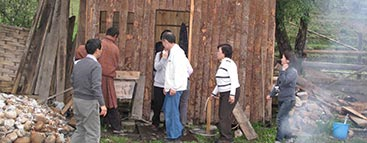
Hot stone bath (Dhotsho) is a traditional bath of Bhutan, where a tradition of heating up stones and then soaking in the water that is in turn heated by the stones. This is also a curative method and is used throughout the country We Bhutanese belief that this bath has so much of medicinal benefits. Some diseases are curable-like joint pains, hypertension, stomach disorder, arthritis and many other minor diseases. Especially for the old age, where we have lots of body pains, joints pains helps a lot by this Hot Stone Bath (Dhotsho).
I think, the minerals in the rocks have certain chemicals, which can cure certain disease of our body. Hot stone bath has no side effects. It is in its pure natural form. We can organize the hot stone bath during your stay in Bhutan.
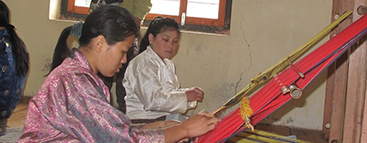
The Bhutanese textiles are rich, vibrant, and colorful and are a complex art form as well as an integral part of the Bhutanese culture. This Bhutan weaving experiences will give you an insight about the rich textiles in Bhutan. You can sit one of the handlooms of Bhutan and weave your self practically. We promise that you will really enjoy this with great satisfaction in your life.
We will also see or learn the natural coloring and dyeing. You can bring your own materials like handkerchief to dye and color. So visit Bhutan and experience it practically by yourself.
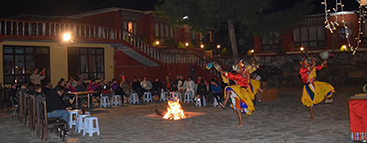
Folk Performing Arts & Music in the Himalayan Kingdom of Bhutan
We have Cultural Program Performing groups, which they will perform like Traditional folk songs, dances and keeps original tunes and dances alive. Moreover, new choreography for some traditional and regional songs is sometimes developed.
The troupe also performs mask dances that have historical and spiritual significance.
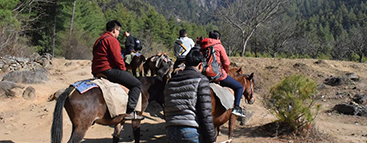
Tiger’s Nest is most visited spot in Bhutan and it is much awaited by every tourist who visits Bhutan to climb to Tiger’s Nest.
It takes about 2 hrs 30mins up steep climb through the forest of pine, oak and Rhododendron. However you can ride the horse and climb till the Taktshang cafeteria.


